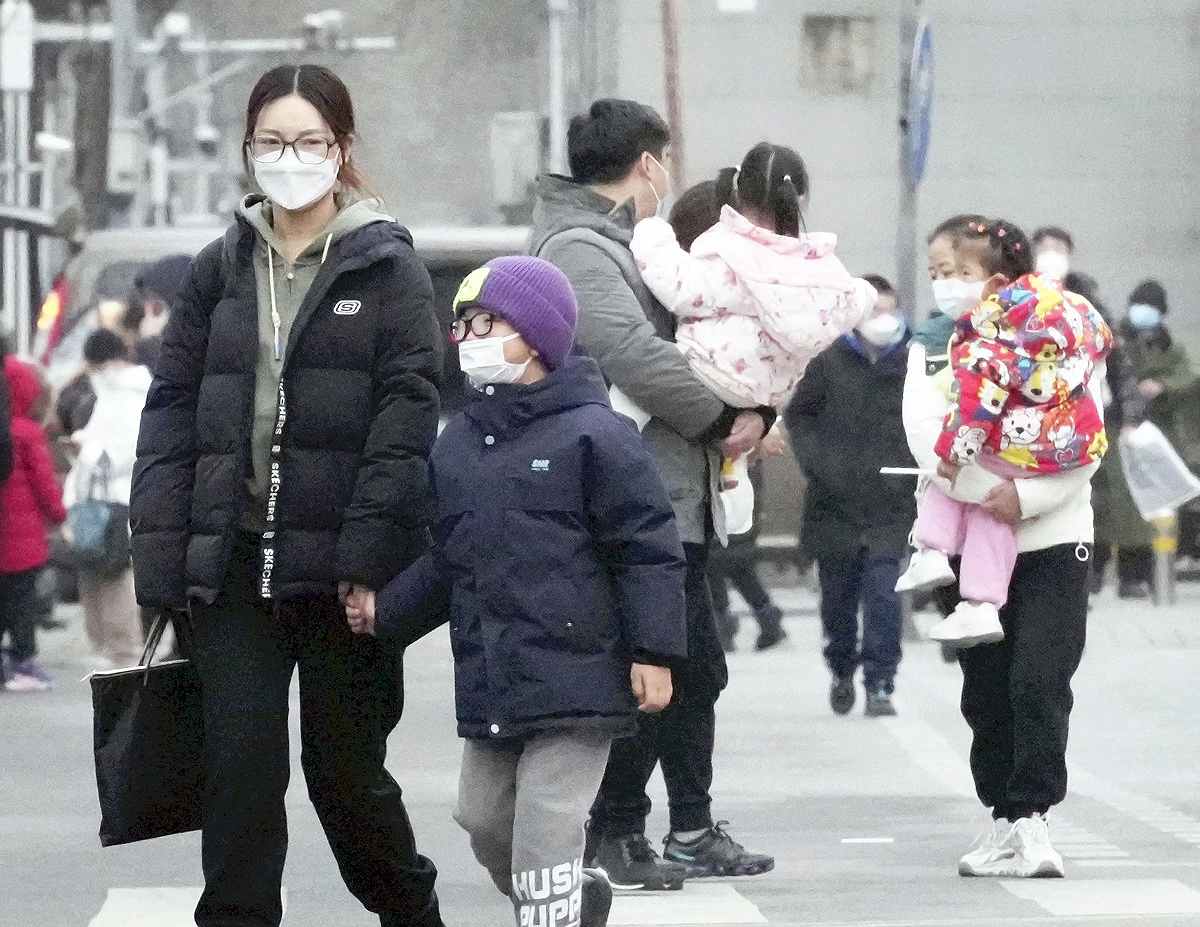
A woman walks with a child in Beijing on Friday.
21:00 JST, January 18, 2023
BEIJING — China, a country that has achieved economic development driven by the world’s largest labor force, has logged a population decline for the first time in 61 years.
With the population likely to shrink further in the years ahead, the situation might affect the “strong nation” policy of the Xi Jinping administration, which aims to rival the United States.
The structural changes in the world’s second-largest economy are also likely to impact the global economy in the long term.
8 years early
Regarding the decline in China’s population, U.S.-based researcher Yi Fuxian said the Chinese government will be forced to change its policies, which can be considered an inflection point.
Until now, China has enjoyed a period of “demographic dividend,” with a high proportion of working-age people in the population, which is considered favorable for economic growth. However, the percentage of working-age people aged 16-59 in the population fell from 74.5% in 2010 to 68.3% in 2021.
Average life expectancy in China increased by more than 10 years over a 40-year period to 77.93 as of July 2022. Meanwhile, the country’s social security expenditure rose to about ¥69 trillion in 2021, marking a 2.7-fold increase over 10 years.
As the population ages, the increase in social security costs, including pensions, will put pressure on public finances. Domestic policies based on the assumption of a steadily rising population will need to be reviewed.
In 2019, the Chinese Academy of Social Sciences, a government-affiliated research institute, forecasted that China’s population would peak in 2029 and begin to decline in 2030. According to the latest data, the population decline has started eight years earlier than expected.
Education costs
The country’s last population decline in 1961 was the result of a severe famine triggered by the failure of the Chinese Communist Party Chairman Mao Zedong’s Great Leap Forward campaign. The population increased the following year.
This time, however, the population decline was due to structural change. The birth rate is the lowest it has ever been and is likely to remain low.
The Xi administration has promoted measures to combat the declining birthrate, such as increasing the number of childcare facilities and providing child-rearing subsidies, but the effects have been limited so far.
Higher education costs have been soaring in China. A 38-year-old Beijing resident who has an 8-year-old son said, “My parents and husband want us to have a second child, but considering the costs and the burden of raising children, one is enough.”
China’s zero-COVID policy has caused an economic slowdown. The unemployment rate for 16- to 24-year-olds has risen to 16.7% and young people in the age group are increasingly shying away from marriage and childbirth due to uncertainties about the future.
A 34-year-old IT worker in Shanghai said, “The zero-COVID policy has really exhausted me. I’ve totally lost the sense of security that I can get married and raise a child.”
Biggest trading partner
The rapid growth triggered by reforms that began in 1978 was underpinned by an abundant and cheap labor force.
The Xi administration has used economic growth as a tool to achieve the goal of becoming a modernized socialist powerhouse that can rival the United States by the mid-21st century.
However, it has become difficult for China to find positive factors for economic growth, amid population decline, soaring wages, and the confrontation between Washington and Beijing. If economic growth slows further, doubts may arise about the legitimacy of the CCP’s one-party dominance.
There may also be an impact on the global economy in the medium to long term.
China has been a driving force in the global economy since 2010 when it overtook Japan to become the world’s second-largest economy.
China’s contribution to global economic growth averaged 39% from 2013 to 2021, according to an online report in the People’s Daily that cited World Bank data. The percentage is far higher than the combined total of 26% for the Group of Seven nations — with the United States at 19% and Japan at 1%.
The nation’s strong purchasing power is behind its contribution to global economic growth.
China’s population of 1.4 billion has a so-called middle class with yearly incomes of 60,000-500,000 yuan (about ¥1.2 million-¥9.5 million) comprising about 340 million people.
The impact of China’s population decline is expected to be significant in Japan as China is Japan’s largest trading partner, accounting for more than 20% of total imports and exports.
Among the Japanese, U.S., and European companies that aggressively expanded operations in China due to the abundant labor force, the shrinking population may make them reconsider their investment strategies.
"World" POPULAR ARTICLE
-

8 Japanese Nationals Stranded on Indonesia’s Sumatra Island
-

Mozambican Cooking Class Held in Matsuyama, Ehime Pref.; Participants Don Aprons, Bandanas Made from Traditional Mozambique Fabric
-

China to Impose Sanctions on Shigeru Iwasaki, Former Head of Japan’s Self-Defense Forces, Who Serves as Adviser to Taiwan’s Executive Branch
-

U.S. Senate Resolution Backs Japan, Condemns China’s Pressure
-

South Korea’s Top Court Dismisses Nippon Steel Appeal in Lawsuit over Requisitioned Worker
JN ACCESS RANKING
-

Keidanren Chairman Yoshinobu Tsutsui Visits Kashiwazaki-Kariwa Nuclear Power Plant; Inspects New Emergency Safety System
-

Imports of Rare Earths from China Facing Delays, May Be Caused by Deterioration of Japan-China Relations
-

University of Tokyo Professor Discusses Japanese Economic Security in Interview Ahead of Forum
-

Japan Pulls out of Vietnam Nuclear Project, Complicating Hanoi’s Power Plans
-

Govt Aims to Expand NISA Program Lineup, Abolish Age Restriction



















